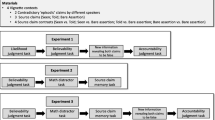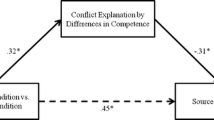Abstract
In two crucial test experiments pitting altercasting against traditional source credibility theories (Hovland, Janis, & Kelley, 1953; Kelman, 1958), students received a message emphasizing either technical or protective themes attributed to a child or an expert. Traditional theories predict an expert should be more effective than a child. According to altercasting theory, credibility is a function of the privileges and responsibilities associated with positions in a role-set. A child places a message recipient into the role of protector and is most effective when arguing for protective as opposed to technical messages. An expert is most effective when arguing within a domain of expertise (technical issues) as opposed to common opinion. The results overwhelmingly support an altercasting interpretation of source credibility.
Similar content being viewed by others
References
Applbaum, R.L., & Anatol, K.W. (1973). Dimensions of source credibility: A test for reproducibility. Speech Monographs, 40, 231–237.
Aristotle, (circa 350 B.C.E./1954). Rhetoric. New York: Modern Library.
Arnauld, A., & Nicole, P. (1662/1996). Logic or the art of thinking. Cambridge: Cambridge University Press.
Aronson, E., & Golden, B.W. (1962). The effects of relevant and irrelevant aspects of communicator credibility on opinion change. Journal of Personality, 30, 135–146.
Durkheim, E. (1933). The division of labor in society. New York: Macmillan.
Eagly, A. H., Chaiken, S., & Wood, W. (1981). An attribution analysis of persuasion. In J.H. Harvey, W. Ickes, & R.F. Kidd (Eds.), New directions in attribution research (pp. 37–62). Hillsdale, NJ: Lawrence Erlbaum.
Eagly, A.H., Wood, W., & Chaiken, S. (1978). Causal inferences about communicators and their effects on opinion change. Journal of Personality and Social Psychology, 36, 424–435.
Forsyth, D.R. (1976). Crucial experiments and social psychology inquiry. Personality and Social Psychology Bulletin, 2, 454–459.
Gerver, I., & Bensman, J. (1954). Towards a sociology of expertness. Social Forces, 32, 226–235.
Giffin, K. (1967). The contribution of studies of source credibility to a theory of interpersonal trust in the communication process. Psychological Bulletin, 68, 104–120.
Goode, W. J. (1968). Norm commitment and conformity to role-status obligations. American Sociological Review, 33, 246–258.
Greenwald, A.G. (1975). On the inconclusiveness of “crucial” cognitive tests of dissonance versus self-perception theories. Journal of Experimental Social Psychology, 11, 490–499.
Greenwald, A.G., Pratkanis, A.R., Leippe, M.R., & Baumgardner, M.H. (1986). Under what conditions does theory obstruct research progress? Psychological Review, 93, 216–229.
Greenwald, A.G., & Ronis, D.L. (1981). On the disconfirmation of theories. Personality and Social Psychology Bulletin, 7, 131–137.
Haley, R.I., & Baldinger, A. L. (1991, April/May). The ARF copy research validity project. Journal of Advertising Research, 11–32.
Hovland, C.I., Janis, I.L., & Kelley, H.H. (1953). Communication and persuasion. New Haven, CT: Yale University Press.
Hovland, C.I., & Weiss, W. (1951). The influence of source credibility on communication effectiveness. Public Opinion Quarterly, 15, 635–650.
Kelman, H.C. (1958). Compliance, identification, and internalization: Three processes of attitude change. Journal of Conflict Resolution, 2, 51–60.
Kelman, H.C. (1961). Processes of opinion change. Public Opinion Quarterly, 25, 57–78.
Kelman, H.C. (1974). Further thoughts on the processes of compliance, identification, and internalization. In J.T. Tedeschi (Ed.), Perspectives on social power (pp. 125–171). Chicago: Aldine Publishing.
Lamb, C. (1823/1935). Witches, and other night fears. In The complete works and letters of Charles Lamb (pp. 57–61). New York: Modern Library.
Leary, M.R. (1979). Levels of disconfirmability and social psychological theory: A response to Greenwald. Personality and Social Psychology Bulletin, 5, 149–153.
Lord, C.G., Ross, L., & Lepper, M.R. (1979). Biased assimilation and attitude polarization: The effects of prior theories on subsequently considered evidence. Journal of Personality and Social Psychology, 37, 2098–2109.
McGinnies, E., & Ward, C.D. (1980). Better liked than right: Trustworthiness and expertise as factors in credibility. Personality and Social Psychology Bulletin, 6, 467–472.
McGuire, W. J. (1985). Attitudes and attitude change. In G. Lindzey and E. Aronson (Eds.), Handbook of social psychology (3rd ed., pp. 223–346). New York: Random House.
Merton, R. K. (1957). The role-set problem: Problems in sociological theory. British Journal of Sociology, 8, 106–120.
Milgram, S. (1984, August). Cyranoids. Paper presented at the meeting of the American Psychological Association, Toronto, Canada. [Reprinted in S. Milgram. (1994). The individual in a social world (2nd ed., pp. (337–345). New York: McGraw-Hill.]
Miller, R.L., Brickman, P., & Bolen, D. (1975). Attribution versus persuasion as a means of modifying behavior. Journal of Personality and Social Psychology, 31, 430–441.
Nisbett, R.E., & Wilson, T.D. (1977). Telling more than we can know: Verbal reports on mental processes. Psychological Review, 84, 231–259.
Ostrom, T.M. (1972). Item construction in attitude measurement. Public Opinion Quarterly, 35, 593–600.
Petty, R.E., & Cacioppo, J.T. (1986). Communication and persuasion: Central and peripheral routes to attitude change. New York: Springer-Verlag.
Plato (circa 400 B.C.E./1961). The complete dialogues of Plato. Princeton, NJ: Princeton University Press.
Pornpitakpan, C. (2004). The persuasiveness of source credibility: A critical review of five decades' evidence. Journal of Applied Social Psychology, 34, 243–281.
Powell, F.C., & Wanzenried, J. W. (1995). Do current measures of dimensions of source credibility produce stable outcomes in replicated tests? Perceptual and Motor Skills, 81, 675–687.
Pratkanis, A.R. (2000). Altercasting as an influence tactic. In D.J. Terry & M. A. Hogg (Eds.), Attitudes, behavior, and social context (pp. 201–226). Mahwah, NJ: Lawrence Erlbaum.
Pratkanis, A.R., & Aronson, E. (2001). Age of propaganda: The everyday use and abuse of persuasion (Revised edition). New York: W. H. Freeman/Holt.
Pratkanis, A.R., & Greenwald, A.G. (1989). A socio-cognitive model of attitude structure and function. In L. Berkowitz (Ed.), Advances in Experimental Social Psychology (Vol. 22, pp. 245–285). New York: Academic Press.
Pratkanis, A.R., & Uriel, Y. (2004). The Expert Snare as an Influence Tactic: Surf, Turf, and Ballroom Demonstrations of the Compliance Consequences of Being Altercast as an Expert. Unpublished manuscript, University of California, Santa Cruz.
Rakover, S.S. (1981). Social psychology theory and falsification. Personality and Social Psychology Bulletin, 7, 123–130.
Salancik, G.R., & Conway, M. (1975). Attitude inferences from salient and relevant cognitive content about behavior. Journal of Personality and Social Psychology, 32, 829–840.
Walster, E., Aronson, E., & Abrahams, D. (1966). On increasing the persuasiveness of a low prestige communicator. Journal of Experimental Social Psychology, 2, 325–342.
Watts, I. (1724/1996). Logic: The right use of reason in the inquiry after the truth. Morgan, PA: Soli Deo Gloria Publications.
Weinstein, E.A., & Deutschberger, P. (1963). Some dimensions of altercasting. Sociometry, 26, 454–466.
Weinstein, E.A., & Deutschberger, P. (1964). Task, bargains, and identities in social interaction. Social Forces, 42, 451–456.
White, P. H., & Harkins, S. G. (1994). Race of source effects in the elaboration likelihood model. Journal of Personality and Social Psychology, 67, 790–807.
Author information
Authors and Affiliations
Corresponding author
Rights and permissions
About this article
Cite this article
Pratkanis, A.R., Gliner, M.D. And when shall a little child lead them? evidence for an altercasting theory of source credibility. Curr Psychol 23, 279–304 (2004). https://doi.org/10.1007/s12144-004-1002-5
Issue Date:
DOI: https://doi.org/10.1007/s12144-004-1002-5




